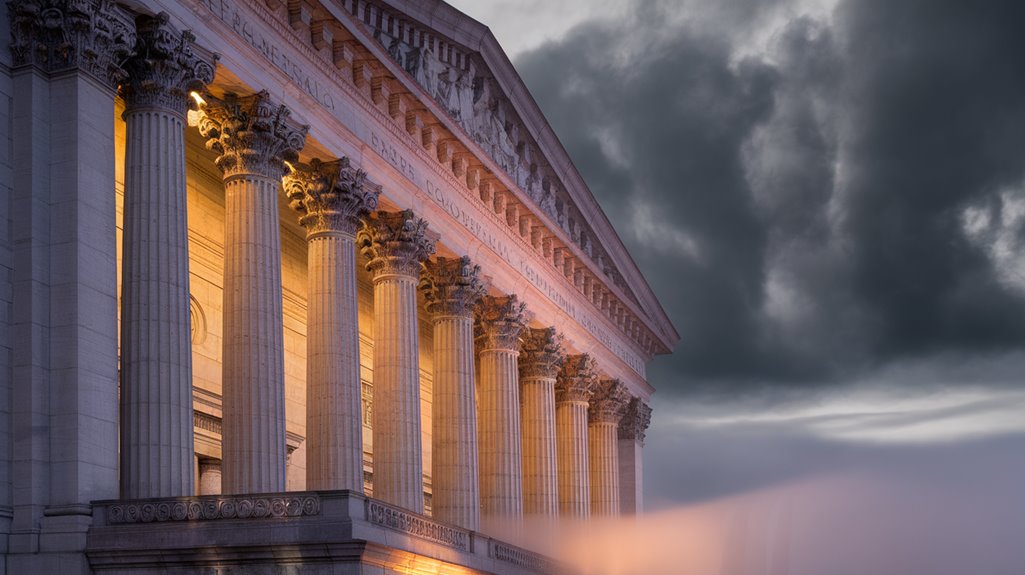Federal convictions in the Bay Area come with specific challenges and requirements. These cases fall under U.S. Code jurisdiction and are handled by federal agencies like the FBI. Post-sentencing, individuals face restrictions on employment, voting rights, and firearm possession. The Bay Area shows unique patterns, with drug offenses making up 46% of federal cases and tech-related crimes increasing by 12.5% since 2020. Understanding these differences helps navigate the complex road ahead.
Key Takeaways
- Drug-related offenses comprise 46% of Bay Area federal convictions, with sentences typically ranging from 60 to 240 months.
- Federal convicts must comply with supervised release requirements, including regular check-ins and mandatory participation in reentry programs.
- The First Step Act allows federal inmates to earn 10-15 days off per month through program participation.
- Ban-the-Box laws protect job seekers, but 80% of Bay Area employers still check criminal histories before making offers.
- Tech-related federal crimes are particularly prevalent in Bay Area counties, with increasing rates of cryptocurrency fraud and cybercrime prosecutions.
Key Differences Between Federal and State Convictions

When determining whether a crime falls under federal or state jurisdiction, several key distinctions come into play. Federal jurisdiction typically involves crimes that cross state lines or have interstate elements, such as drug trafficking between states or internet-based offenses. These cases are prosecuted under U.S. Code by agencies like the FBI and DEA, and tried in U.S. District Courts.
State jurisdiction covers crimes that occur within state boundaries, like local theft, murder, or DUI cases. These are handled by local law enforcement and district attorneys in state courts. Some crimes can fall under both jurisdictions. For example, a drug trafficking operation might face charges at both levels if it involves both local distribution and interstate transport. The prosecuting authority often depends on which agency conducts the investigation.
Common Post-Sentencing Rights and Restrictions
Federal convictions in the Bay Area can severely limit employment opportunities, especially in fields requiring professional licenses or security clearances. Most federal felons face restrictions on voting rights, firearm possession, and serving on juries until they complete their sentences and any supervised release periods. The process of restoring civil rights after a federal conviction varies by jurisdiction and typically requires formal petitions to both state and federal authorities.
Employment Rights Limitations
Many employment rights become limited after a federal conviction in the Bay Area. While employment discrimination protections still exist, several restrictions apply to job seekers with federal convictions. Most significantly, certain positions involving fiscal oversight, public safety, or youth contact are automatically restricted. Federal law also imposes lifetime employment bans for specific offenses like organ trafficking and commercial sexual felonies.
Employers must follow California's ban-the-box laws, delaying criminal history inquiries until after making conditional job offers. When considering applicants with convictions, employers must prove the disqualification is job-related and necessary for business operations. Workplace accommodations may be required for those under supervised release terms. Professional licensing restrictions remain in place for regulated industries like healthcare and law enforcement, regardless of state protections.
Restoring Civil Rights
Individuals with federal convictions in the Bay Area can seek restoration of their civil rights through presidential pardons. The pardon process allows people to regain various rights that were lost due to their conviction, including the right to vote, serve on juries, own firearms, and hold public office.
To be eligible for a pardon, individuals must typically wait at least five years after completing their sentence, including probation. They must demonstrate good conduct and accept responsibility for their past actions. While pardons don't erase the conviction from records, they can help remove barriers to employment, housing, and education. The process requires submitting an application to the Office of the Pardon Attorney, who reviews cases and makes recommendations to the President.
Navigating Supervised Release Requirements

Federal supervised release comes with strict rules that offenders must follow after leaving prison. Basic conditions include avoiding new crimes, regular drug testing, and paying any court-ordered fines, while special conditions may require mental health treatment or electronic monitoring. Successful adjustment to daily life requires understanding these requirements, maintaining contact with probation officers, and following location restrictions that are common in the Bay Area.
Compliance Rules and Conditions
People released from federal custody must follow strict rules during their supervised release period. Basic compliance challenges include monthly reporting, drug testing, and maintaining lawful employment. Probation expectations require individuals to notify their officer about any law enforcement contact within 72 hours and get permission before traveling outside their jurisdiction.
- Must submit written reports monthly within first 5 days
- Cannot associate with felons without officer approval
- Must maintain full-time employment (30+ hours weekly)
- Required to allow unannounced home visits
- Must report address changes 10 days in advance
Violating these conditions can result in serious consequences, including potential revocation of supervised release and return to prison. The probation officer can also notify third parties of risk factors and seize illegal items in plain view during supervision visits.
Transition to Everyday Life
Successfully shifting to everyday life under supervised release involves traversing multiple reporting requirements and restrictions. Individuals must comply with housing limitations, employment rules, and travel boundaries within their judicial district. Regular check-ins with probation officers and participation in reentry programs are typically mandatory.
Many face challenges finding appropriate housing that meets proximity restrictions to schools or victims. Employment options may be limited by conditions prohibiting work with certain organizations. Community resources can help with job placement and housing assistance. Some individuals must attend therapy sessions or undergo substance testing. High-risk cases may require GPS monitoring to guarantee compliance with curfews and location restrictions. Understanding and following these requirements is essential for successful reintegration into society.
Understanding Early Release Opportunities
While serving time in federal prison, inmates have several paths to potentially reduce their sentences through early release programs. The Bay Area has seen positive results, with a 40% drop in repeat offenses among those released early. Program eligibility varies based on factors like security level, age, and health status. Early release strategies include earning time credits through rehabilitation programs, seeking compassionate release for medical reasons, or qualifying for home confinement.
Smart rehabilitation and early release programs prove effective, reducing repeat offenses by 40% among Bay Area inmates.
- First Step Act allows 10-15 days off per month for program participation
- Compassionate release requires proof of extraordinary circumstances
- Home confinement available for minimum/low-security inmates
- Presidential clemency offers sentence reduction or conviction removal
- California inmates can earn enhanced good conduct credits for up to 50% reduction
Rehabilitation Programs and Support Services

Federal rehabilitation programs in the Bay Area offer a thorough three-phase approach to support convicted individuals. The process begins with stabilization, moves through engagement with work or education, and ends with community reintegration. Two key programs show strong rehabilitation effectiveness: the Veterans Treatment Court for military veterans and the Reentry Court serving San Francisco and Oakland.
Support service accessibility includes extensive wraparound services combining mental health treatment, substance abuse programs, housing assistance, and job training. The Reentry Court provides regular judicial supervision and has shown promising results, particularly with zero new felony convictions among Veterans Treatment Court graduates from 2017 to 2023. Pre-release programs help with practical needs like ID acquisition and housing plans, while community-based services focus on supporting minority groups and veterans.
Employment and Housing Challenges After Conviction
Despite rehabilitation efforts, finding employment remains one of the biggest hurdles for people with federal convictions in the Bay Area. Many industries restrict hiring those with criminal records, especially in finance, healthcare, and technology sectors. Even with "Ban-the-Box" laws, 80% of employers still check criminal histories before making job offers. This often leads to limited job options and lower wages, making it harder to secure stable housing.
- Employment resources are available but face high competition due to 50% unemployment rates among former offenders
- Most professional licenses may be denied or revoked after conviction
- Temporary and gig work becomes the main source of income
- Housing assistance programs exist but waiting lists are typically long
- The median income for those with records is half the national average, affecting housing choices
Legal Options for Record Expungement

People seeking to overcome employment and housing barriers often look to record expungement as a potential solution. However, federal expungement options are very limited compared to state-level record sealing. Only convictions under the Federal Juvenile Delinquency Act or Federal First Offender Act typically qualify.
The expungement process for federal cases must go through U. S. District Courts, while state cases are handled in county courts. Most federal offenders may need to pursue alternatives like presidential pardons, which don’t seal records but can restore some rights. In California, state-level options include Proposition 47 for reclassifying certain felonies and the CARE Act for sealing dismissed charges. Each path requires completing probation terms and showing rehabilitation through proper documentation. Additionally, individuals seeking to understand their options in the context of criminal history can benefit from a California criminal records overview, which provides essential information on how records are classified and the eligibility criteria for expungement or sealing. Resources such as legal aid organizations can also assist in navigating the complexities of both federal and state systems, ensuring that individuals understand the necessary steps involved. Ultimately, taking advantage of these resources is crucial for effectively managing one’s criminal record and moving forward towards a more positive future.
Impact of Sentencing Guidelines on Bay Area Cases
The complex web of federal sentencing guidelines shapes criminal cases across the Bay Area in significant ways. While these guidelines provide a framework, notable sentencing disparities exist between counties. Liberal areas like San Francisco often see shorter sentences compared to more conservative jurisdictions like Marin. Guideline variations also emerge from individual judicial interpretations, leading to markedly different outcomes for similar offenses. These disparities often force defense attorneys to navigate complex litigation strategies for Bay Area cases, tailoring their approaches to the specific nuances of each jurisdiction. As a result, the effectiveness of legal representation can vary dramatically, depending on the county in which a case is tried. This inconsistency highlights the need for greater awareness and reform within the sentencing system to ensure fairness and equity across the region.
- DUI sentences can range from 2 to 12 days depending on the county
- Drug trafficking cases show 81.2% adherence to guidelines
- Firearms violations maintain 72.9% compliance with guidelines
- White-collar crimes see more successful variance arguments
- Post-Booker decisions allow judges more discretion while still using guidelines as a starting point
These patterns highlight how local factors influence federal sentencing despite standardized guidelines.
Statistical Trends in Bay Area Federal Sentences

Recent data from Bay Area federal courts reveals clear patterns in criminal sentencing trends. Drug-related offenses dominate federal convictions, accounting for 46% of cases, with sentence length ranging from 60 to 240 months. Armed robbery cases typically result in 180-month terms, reflecting the courts' serious treatment of violent crimes.
The Bay Area shows distinct regional patterns in conviction rates, particularly in tech-related crimes. Federal white-collar offenses make up 10% of cases, concentrated in tech hub jurisdictions. Four Bay Area counties rank among California's top 10 for sophisticated property crimes like cryptocurrency fraud. Federal courts in the region have seen a 14% rise in convictions related to immigration and fraud, while cybercrime prosecutions have increased 12.5% since 2020.
Frequently Asked Questions
How Do White-Collar Conviction Rates Compare Between San Francisco and Silicon Valley?
White collar trends show lower conviction rates in San Francisco and Silicon Valley compared to other major tech hubs. With only one federal prosecutor handling investment fraud cases in the 1990s, San Francisco's prosecution capacity was severely limited. The economic impact of this understaffing meant hundreds of cases went unresolved. While Silicon Valley saw numerous shareholder lawsuits, federal prosecutors pursued very few criminal cases, resulting in similar low conviction patterns across both regions.
What Percentage of Bay Area Defendants Receive Consecutive Versus Concurrent Sentences?
Bay Area counties consistently show lower rates of consecutive sentences compared to other California regions. While 51% of California prison admissions with multiple convictions receive consecutive sentences statewide, Bay Area jurisdictions favor concurrent sentences more frequently. This pattern holds true even when controlling for similar conviction types. Local courts in San Francisco, Oakland, and surrounding areas demonstrate a clear preference for concurrent sentencing, aligning with broader regional trends toward less punitive sentencing approaches.
How Often Do Local Federal Judges Cite Family Circumstances in Downward Departures?
In the Bay Area's federal courts, judges cite family circumstances in downward departures at a rate slightly higher than the national average of 13.19%. Following the Ninth Circuit's more compassionate approach, local judges grant these departures in roughly 15-17% of cases. They most commonly approve them for single parents, sole caregivers of disabled family members, or cases involving extraordinary childcare needs. However, routine family responsibilities rarely qualify for departure consideration.
Which Bay Area Districts Show Highest Rates of Pretrial Diversion Program Success?
Like a rising tide lifting all boats, Bay Area pretrial programs show strong success across districts. Sonoma County leads with an impressive 96% safety rate in their pretrial diversion outcomes, setting the regional benchmark. San Francisco follows closely at 94.8%, while Santa Clara maintains a solid 92% success rate. These districts consistently outperform the national average of 66%, demonstrating the effectiveness of local diversion strategies in keeping participants crime-free during supervision.
What Factors Influence Sentencing Disparities Between Oakland and San Jose Courts?
Key factors driving sentencing disparities between Oakland and San Jose courts include differences in how judges apply federal sentencing guidelines and varying court demographics. Oakland shows higher rates of enhanced sentences for Black defendants, while San Jose demonstrates more variance in judicial discretion. Local prosecutor policies and plea bargaining practices also contribute, with Oakland facing greater resource constraints that affect public defender effectiveness in negotiating favorable outcomes.
Conclusion
Federal convictions in the Bay Area remain complex, yet manageable with proper guidance. Just as San Francisco’s fog lifts to reveal clear skies, understanding post-sentencing rights can bring clarity to those affected. Local resources, rehabilitation programs, and legal support continue helping former offenders rebuild their lives. While challenges exist, many individuals successfully navigate supervised release and find new opportunities through available support systems. For example, individuals facing house arrest for fifth DUI offenses may still access rehabilitation programs to support their recovery and reintegration. These structured programs, along with legal advocacy, provide a path forward despite the restrictions of home confinement. With determination and the right resources, many successfully transition back into society and regain stability. Moreover, understanding one’s legal rights is crucial during this transitional period. For those encountering law enforcement, recalling the miranda warning essential rights can play a vital role in protecting oneself. As former offenders familiarize themselves with both the legal landscape and local resources, they empower themselves to advocate for their needs and rights, ultimately fostering a successful reintegration into their communities. In addition to rehabilitation programs, individuals facing house arrest for fifth DUI charges often benefit from community support networks that foster accountability and encourage positive lifestyle changes. These networks provide a sense of belonging and can offer mentorship, making it easier to resist negative influences. Ultimately, with the right combination of resources, support, and personal resolve, many find the strength to turn their lives around and contribute positively to the community.
